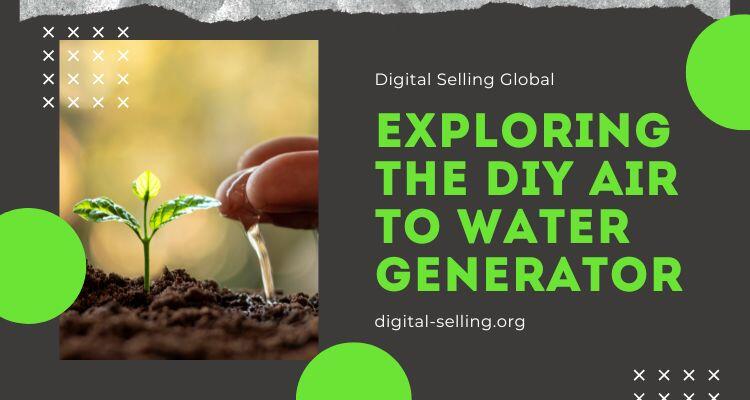This article is about crafting a sustainable future drop by drop by making a DIY air to water generator from home.
In a world increasingly conscious of sustainability, the quest for innovative solutions to water scarcity has led to the rise of DIY projects like the DIY air to water generator. This ingenious contraption harnesses the moisture present in the air, offering a promising alternative to traditional water sources. However, amidst the allure of self-built systems. It’s crucial to weigh the challenges against the convenience of purchasing from established producers like Air Fountain Water Generator.
Understanding the DIY Air to Water Generator
The DIY air to water generator operates on a simple yet fascinating principle: extracting water vapor from the atmosphere and condensing it into potable water. Essentially, it mimics the natural process of condensation, utilizing basic components such as a fan, condenser coils, and a collection reservoir. By leveraging ambient air and a modest energy input, it has the potential to provide a sustainable source of clean drinking water, especially in regions facing water scarcity.
Crafting Sustainability Drop by Drop
One of the primary appeals of the DIY air to water generator lies in its sustainability ethos. By repurposing atmospheric moisture, it circumvents the need for traditional water sources, reducing reliance on finite resources. Moreover, its DIY nature empowers individuals to take charge of their water supply, fostering a sense of self-sufficiency and resilience in the face of environmental challenges.
Building a DIY air to water generator involves a blend of creativity and technical know-how. Enthusiasts can customize their systems to suit specific needs and environmental conditions, whether it’s optimizing efficiency or enhancing portability for off-grid use. Furthermore, the DIY approach fosters a deeper understanding of water conservation and engineering principles, catalyzing innovation at the grassroots level.
Challenges on the DIY Frontier
However, embarking on a DIY endeavor isn’t without its hurdles. Crafting a functional air to water generator requires meticulous planning and attention to detail. From selecting appropriate materials to fine-tuning system components, each step demands precision to ensure optimal performance. Novices may encounter setbacks along the way, from leaks in the condenser coils to inefficiencies in water production.
Moreover, maintenance and troubleshooting can pose ongoing challenges for DIY enthusiasts. Without the support infrastructure of a commercial manufacturer, addressing issues. Such as component wear or system malfunctions may require resourcefulness and DIY ingenuity. While these challenges can foster learning and skill development, they also entail a time and effort investment that some may find daunting.
The Case for Commercial Solutions
In contrast, purchasing an air to water generator from established producers like Air Fountain Water Generator offers a compelling alternative. These systems undergo rigorous testing and quality assurance processes, ensuring reliable performance and durability out of the box. With dedicated customer support and warranty coverage, users benefit from peace of mind and assistance in resolving any issues that may arise.
Commercial solutions also boast advanced features and technological innovations that may surpass the capabilities of DIY counterparts. From integrated filtration systems to smart sensors for efficiency optimization, these offerings represent the forefront of air to water technology. While DIY enthusiasts may eventually incorporate such enhancements into their projects, commercial options provide immediate access to cutting-edge functionality.
Bridging the Gap: Collaboration and Innovation
Rather than viewing DIY and commercial approaches as mutually exclusive, there exists an opportunity for synergy and collaboration. DIY communities serve as hotbeds of innovation, experimenting with novel concepts and pushing the boundaries of what’s possible. By sharing insights and best practices, enthusiasts can collectively advance the state of DIY air to water technology, enriching the broader ecosystem of sustainable solutions.
Likewise, commercial producers can draw inspiration from DIY initiatives, leveraging grassroots innovation to inform product development and market strategy. Engaging with DIY communities fosters a culture of co-creation and knowledge exchange. This concept benefits both parties and ultimately accelerating progress toward a more sustainable future.
Final words about making a DIY air to water generator
The DIY air to water generator embodies the spirit of innovation and self-reliance. It offers a promising avenue for addressing water scarcity through grassroots action. While challenges abound on the DIY frontier, enthusiasts are driven by a shared commitment to sustainability and empowerment. Meanwhile, commercial solutions provide a convenient and reliable alternative, leveraging expertise and resources to deliver cutting-edge technology.
Ultimately, whether DIY or commercial, the pursuit of sustainable water solutions requires collective effort and ingenuity. By bridging the gap between grassroots innovation and established industry, we can harness the full potential of air to water technology, one drop at a time.
